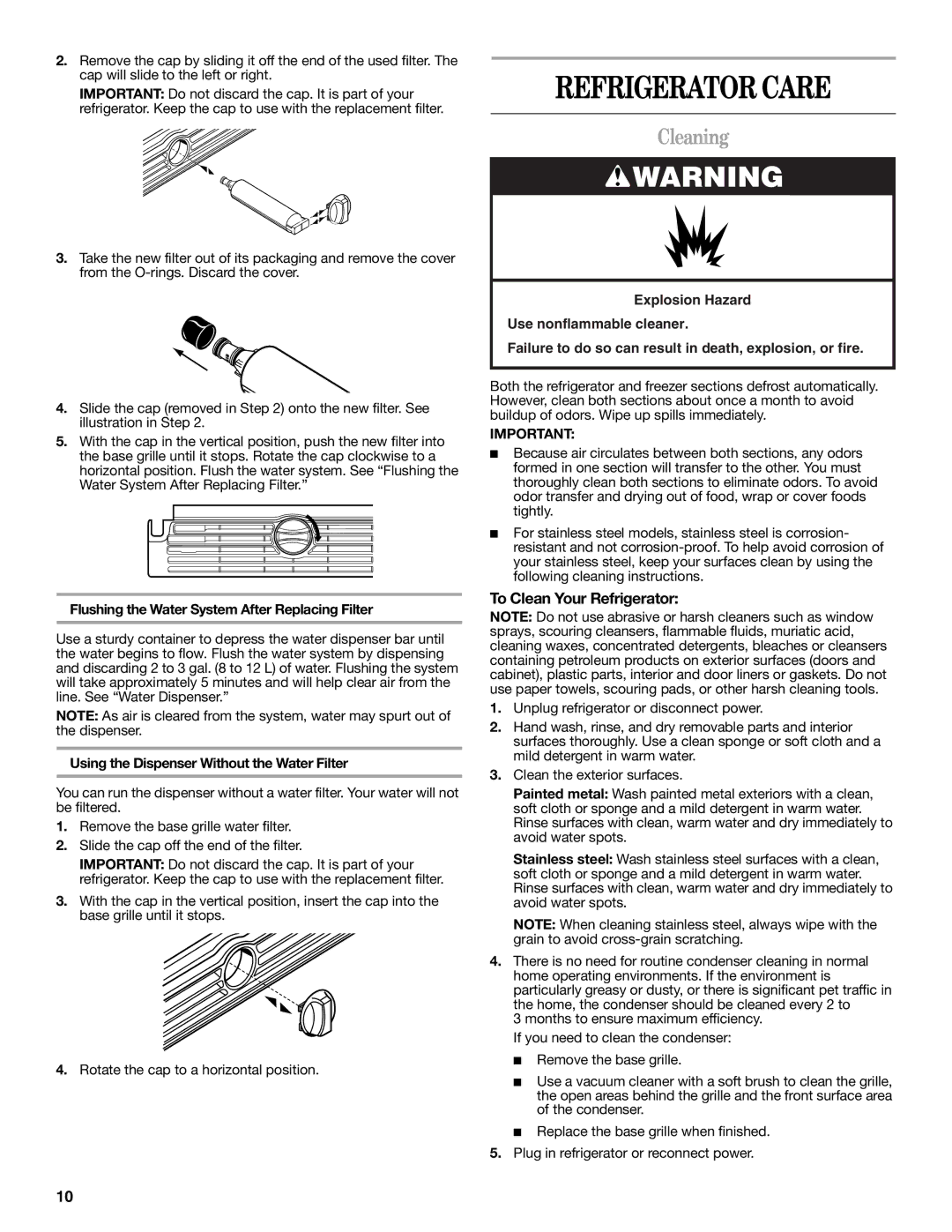
2.Remove the cap by sliding it off the end of the used filter. The cap will slide to the left or right.
IMPORTANT: Do not discard the cap. It is part of your refrigerator. Keep the cap to use with the replacement filter.
3.Take the new filter out of its packaging and remove the cover from the
4.Slide the cap (removed in Step 2) onto the new filter. See illustration in Step 2.
5.With the cap in the vertical position, push the new filter into the base grille until it stops. Rotate the cap clockwise to a horizontal position. Flush the water system. See “Flushing the Water System After Replacing Filter.”
Flushing the Water System After Replacing Filter
Use a sturdy container to depress the water dispenser bar until the water begins to flow. Flush the water system by dispensing and discarding 2 to 3 gal. (8 to 12 L) of water. Flushing the system will take approximately 5 minutes and will help clear air from the line. See “Water Dispenser.”
NOTE: As air is cleared from the system, water may spurt out of the dispenser.
Using the Dispenser Without the Water Filter
You can run the dispenser without a water filter. Your water will not be filtered.
1.Remove the base grille water filter.
2.Slide the cap off the end of the filter.
IMPORTANT: Do not discard the cap. It is part of your refrigerator. Keep the cap to use with the replacement filter.
3.With the cap in the vertical position, insert the cap into the base grille until it stops.
4.Rotate the cap to a horizontal position.
REFRIGERATOR CARE
Cleaning
![]() WARNING
WARNING
Explosion Hazard
Use nonflammable cleaner.
Failure to do so can result in death, explosion, or fire.
Both the refrigerator and freezer sections defrost automatically. However, clean both sections about once a month to avoid buildup of odors. Wipe up spills immediately.
IMPORTANT:
■Because air circulates between both sections, any odors formed in one section will transfer to the other. You must thoroughly clean both sections to eliminate odors. To avoid odor transfer and drying out of food, wrap or cover foods tightly.
■For stainless steel models, stainless steel is corrosion- resistant and not
To Clean Your Refrigerator:
NOTE: Do not use abrasive or harsh cleaners such as window sprays, scouring cleansers, flammable fluids, muriatic acid, cleaning waxes, concentrated detergents, bleaches or cleansers containing petroleum products on exterior surfaces (doors and cabinet), plastic parts, interior and door liners or gaskets. Do not use paper towels, scouring pads, or other harsh cleaning tools.
1.Unplug refrigerator or disconnect power.
2.Hand wash, rinse, and dry removable parts and interior surfaces thoroughly. Use a clean sponge or soft cloth and a mild detergent in warm water.
3.Clean the exterior surfaces.
Painted metal: Wash painted metal exteriors with a clean, soft cloth or sponge and a mild detergent in warm water. Rinse surfaces with clean, warm water and dry immediately to avoid water spots.
Stainless steel: Wash stainless steel surfaces with a clean, soft cloth or sponge and a mild detergent in warm water. Rinse surfaces with clean, warm water and dry immediately to avoid water spots.
NOTE: When cleaning stainless steel, always wipe with the grain to avoid
4.There is no need for routine condenser cleaning in normal home operating environments. If the environment is particularly greasy or dusty, or there is significant pet traffic in the home, the condenser should be cleaned every 2 to
3 months to ensure maximum efficiency. If you need to clean the condenser:
■Remove the base grille.
■Use a vacuum cleaner with a soft brush to clean the grille, the open areas behind the grille and the front surface area of the condenser.
■Replace the base grille when finished.
5.Plug in refrigerator or reconnect power.
10
